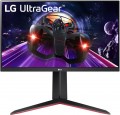Colour depth
The colour depth supported by the monitor.
This parameter characterizes the number of shades that the screen can display. And here it is worth recalling that the image in modern monitors is based on 3 basic colours — red, green, blue (RGB scheme). And the number of bits is indicated not for the entire screen, but for each base colour. For example, 6 bits (the minimum colour depth for modern monitors) means that the screen is capable of producing 2 ^ 6, that is, 64 shades of red, green and blue; the total number of shades will be 64 * 64 * 64 = 262,144 (0.26 million). An
8-bit colour depth (256 shades for each base colour) already gives a total of 16.7 million colours; and the most advanced modern monitors support
10-bit colour, allowing you to work with more than a billion shades.
Screens with support for FRC technology are worth a special mention; nowadays, you can find models marked "
6 bit + FRC " and "
8 bit + FRC ". This technology was developed to improve picture quality in situations where the incoming video signal has a greater colour depth than the screen, such as when 10-bit video is fed to an 8-bit matrix. If such a screen supports FRC, the picture on it will be noticeably better than on a regular 8-bit monitor (although somewhat worse than on a full-fledged 10-bit monitor, but “8 bit + FRC” screens are much
...cheaper).
High colour depth is important primarily for professional graphics and other tasks that require high colour fidelity. On the other hand, such features significantly affect the cost of the monitor. In addition, it is worth remembering that the quality of colour reproduction depends not only on the colour depth, but also on other parameters — in particular, colour gamut (see below).HDR
This technology is designed to expand the range of brightness reproduced by the monitor; Simply put, an HDR model will display brighter whites and darker blacks than a "regular" display. In fact, this means a significant improvement in colour quality. On the one hand, HDR provides a very "live" image, close to what the human eye sees, with an abundance of shades and tones that a normal screen cannot convey; on the other hand, this technology allows to achieve very bright and rich colours.
Modern HDR monitors may use the DisplayHDR designation. This standard takes into account a number of parameters that determine the overall quality of HDR performance: brightness, colour gamut, colour depth, etc. Based on the results of measurements, the monitor is assigned one of the following markings:
DisplayHDR 400 means relatively modest HDR capabilities,
DisplayHDR 600 is average,
DisplayHDR 1000 is above average,
DisplayHDR 1400 is advanced. At the same time, the absence of a DisplayHDR label in itself does not mean anything: it’s just that not every HDR monitor is tested according to this standard.
Note that for the full use of HDR, you need not only
the appropriate monitor, but also content (movies, television, etc.) originally created in HDR. In addition, there are several different HDR techn
...ologies that are not compatible with each other. Therefore, when buying a monitor with this function, it is highly desirable to clarify which version it supports.Portrait pivot
The screen is 90° rotatable on a stand, from landscape (horizontal) to portrait (vertical). The vertical orientation of the screen (
portrait mode) can be useful, for example, when working with large documents made in portrait orientation.
Screen swivel
The presence of
a swivel stand in the design of the monitor allows you to change not only the angle of the screen (of course everyone has it), but also its rotation to the right and left. The angle of rotation depends on the model, but anyway, even a slight deviation allows you to quickly adjust the position of the monitor to your needs.
Height adjustment
The ability to move the monitor screen up and down relative to the base. This feature is very convenient for
adjusting the height of the screen — moving it on the mount is much easier than looking for a stand or resorting to other tricks.
Energy class (new)
This parameter characterizes the efficiency of electricity consumption. Classes are designated in Latin letters from A to G, in ascending order of energy consumption. Actually, this was originally conceived, until more energy-efficient models pulled up to class A, which eventually received the marking A +, A ++, A +++. Further development of technologies allowed us to go even further, and in order not to produce pluses in energy efficiency labeling, in March 2021, manufacturers returned to the previous indices from G to A, where A is the most energy efficient monitor. Accordingly, the 2021 models will have modern markings, while older models will be marked in the same way.

